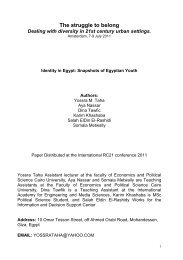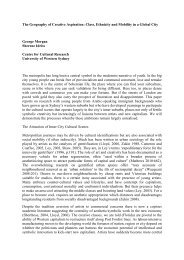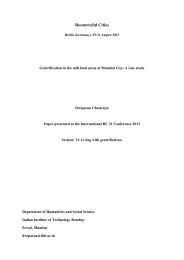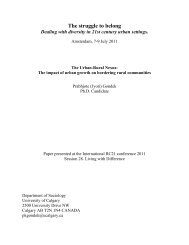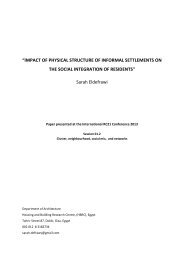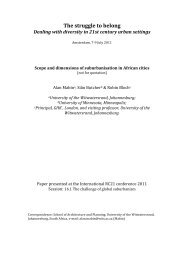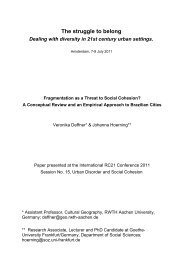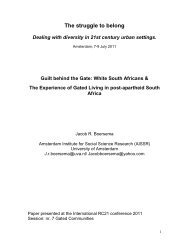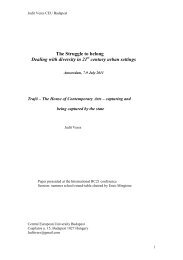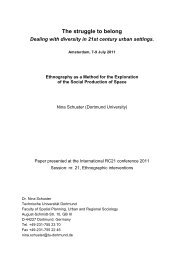The hidden side of metropolization. Governing squats and slums in ...
The hidden side of metropolization. Governing squats and slums in ...
The hidden side of metropolization. Governing squats and slums in ...
Create successful ePaper yourself
Turn your PDF publications into a flip-book with our unique Google optimized e-Paper software.
3<br />
More than one billion people <strong>in</strong> the world could be con<strong>side</strong>red as “squatters” (United Nations, 2003;<br />
Neuwirth, 2004; Davis, 2006). Literature usually focuses on unruly places like <strong>slums</strong> <strong>in</strong> the suburbs<br />
<strong>of</strong> the global cities <strong>in</strong> the South (Fern<strong>and</strong>es <strong>and</strong> Varley, 1998; Aldrich <strong>and</strong> S<strong>and</strong>hu, 1995) or <strong>in</strong><br />
exponential <strong>and</strong> uncontrolled grow<strong>in</strong>g metropolitan areas <strong>in</strong> emerg<strong>in</strong>g countries. Illegal settlements<br />
<strong>and</strong> <strong>squats</strong> are con<strong>side</strong>red as targets <strong>of</strong> public policies <strong>and</strong> particularly <strong>of</strong> large scale regularization<br />
programs. <strong>The</strong>re are few studies on this topic focus<strong>in</strong>g on Europe, though the phenomena described<br />
above are equally present <strong>in</strong> many urban areas <strong>in</strong> Western societies. Sociologists <strong>in</strong>terested <strong>in</strong><br />
“marg<strong>in</strong>ality” address the problems <strong>of</strong> ghettos or “quartiers sensibles” (Wacquant, 2006; Avenel,<br />
2007; Lapeyronnie, 2008; Kokoreff, 2009), but the question <strong>of</strong> illegality is <strong>of</strong>ten put a<strong>side</strong>. Slums are<br />
approached by sociologists <strong>and</strong> geographers who analyze the Roma <strong>and</strong> S<strong>in</strong>ti situation at the marg<strong>in</strong><br />
<strong>of</strong> European metropolises (Legros, 2010; Vitale, 2010). F<strong>in</strong>ally, some French scholars try to<br />
underst<strong>and</strong> the logics <strong>of</strong> “refugee camps” (Agier, 2002, 2008; Bernardot, 2008).<br />
Yet, there are many illegal settlements persist<strong>in</strong>g at the doors <strong>of</strong> European cities <strong>in</strong> different forms,<br />
namely, <strong>squats</strong> <strong>in</strong> build<strong>in</strong>gs or illegal occupations <strong>of</strong> l<strong>and</strong>. I propose here to address these two k<strong>in</strong>ds<br />
<strong>of</strong> occupations. This paper addresses the case <strong>of</strong> Paris at the metropolitan scale. Squats <strong>and</strong> <strong>slums</strong><br />
could appear as two different practices but they are both illegal occupations <strong>of</strong> space <strong>in</strong> order to get a<br />
house <strong>and</strong> a place to live or survive. Many differences can be underl<strong>in</strong>ed: forms <strong>of</strong> mobilizations,<br />
locations, populations liv<strong>in</strong>g <strong>in</strong>, temporalities <strong>and</strong> spaces. However, here, I wish to <strong>in</strong>tegrate these<br />
two k<strong>in</strong>ds <strong>of</strong> occupations <strong>in</strong> the same analysis <strong>in</strong> order to underst<strong>and</strong> the features <strong>of</strong> the public<br />
policies implemented towards urban spaces’ illegal occupations as well as the underly<strong>in</strong>g logic.<br />
<strong>The</strong> question <strong>of</strong> <strong>squats</strong> <strong>and</strong> <strong>slums</strong> is deeply related to three ma<strong>in</strong> problems. <strong>The</strong> first concerns the<br />
hous<strong>in</strong>g. <strong>The</strong> European cities experience an important hous<strong>in</strong>g shortage <strong>and</strong> the recent global crisis<br />
has re<strong>in</strong>forced this trend. In France, the last national survey on hous<strong>in</strong>g (Annual Report <strong>of</strong> Fondation<br />
Abbé Pierre, 2011) shows that more than 3.6 millions <strong>of</strong> people live <strong>in</strong> precarious hous<strong>in</strong>g<br />
conditions. Among them, more than 600 000 people don’t have a ro<strong>of</strong>. Paris is one <strong>of</strong> the densest<br />
European capitals <strong>and</strong> space is a scarce resource. However, paradoxically, we estimate that 9% <strong>of</strong> the<br />
hous<strong>in</strong>g <strong>in</strong> Paris is vacant 2 (more than 120 000 free hous<strong>in</strong>g) 3 . Public actors are not able to provide<br />
hous<strong>in</strong>g to all citizens because <strong>of</strong> a lack <strong>of</strong> fund<strong>in</strong>g, <strong>of</strong> space <strong>and</strong> sometimes <strong>of</strong> political decisions.<br />
This govern<strong>in</strong>g failure generates <strong>and</strong> re<strong>in</strong>forces the development <strong>of</strong> sub-systems (Mayntz, 1993) <strong>of</strong><br />
self organization to get a place to live with the m<strong>in</strong>imal vital services. Legality is too expensive (De<br />
Soto, 2000) <strong>and</strong> actors survive by develop<strong>in</strong>g alternative strategies beyond the logic <strong>of</strong> property<br />
ownership <strong>and</strong> beyond public control <strong>of</strong> space.<br />
We are com<strong>in</strong>g here to the second ma<strong>in</strong> po<strong>in</strong>t: the <strong>metropolization</strong>. I conceive <strong>metropolization</strong> as a<br />
three dimensions process. <strong>The</strong> first dimension concerns spaces <strong>and</strong> territories. A metropolis spreads<br />
cont<strong>in</strong>uously <strong>and</strong> public actors have to keep control on extend<strong>in</strong>g spaces. <strong>The</strong> study is concerned<br />
with the way <strong>in</strong> which they try to exercise power on <strong>in</strong>formal <strong>and</strong> <strong>hidden</strong> spaces. A geographical<br />
perspective could be adopted to underl<strong>in</strong>e the different logics. <strong>The</strong> second dimension is related to the<br />
citizenship question: do citizens participate to the construction <strong>of</strong> their city Do they have any role <strong>in</strong><br />
the urban <strong>and</strong> local governance Can squatters <strong>and</strong> slum dwellers be con<strong>side</strong>red as full citizens <strong>The</strong><br />
third dimension concerns the governance <strong>of</strong> illegal spaces. Who is <strong>in</strong> charge to build <strong>and</strong> govern the<br />
metropolis Who governs <strong>squats</strong> <strong>and</strong> <strong>slums</strong>, <strong>and</strong> how<br />
However the last dimension <strong>of</strong> <strong>metropolization</strong> (who governs the city <strong>and</strong> how) supposes to ask<br />
another question which is central for my research: is the city governable Some scholars propose the<br />
hypothesis <strong>of</strong> the ungovernability <strong>of</strong> society (Mayntz, 1993) <strong>and</strong> <strong>of</strong> metropolises (Jouve <strong>and</strong> Lefèvre,<br />
2 Nevertheless, these vacant hous<strong>in</strong>gs are not only vacant dur<strong>in</strong>g long period but are ma<strong>in</strong>ly the results <strong>of</strong> “turn over”,<br />
relocations or renovation programs. Thus, we cannot estimate precisely how many houses are vacant for a long period<br />
(Driant, 2009).<br />
3 Insee-Local Datas, Paris, datas from Insee, RP1968 à 1990 dénombrements - RP1999 <strong>and</strong><br />
RP2006exploitationspr<strong>in</strong>cipales: http://www.statistiqueslocales.<strong>in</strong>see.fr/FICHES/DL/DEP/75/COM/DL_COM75056.pdf




